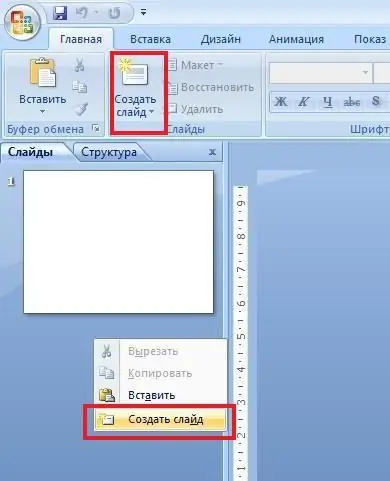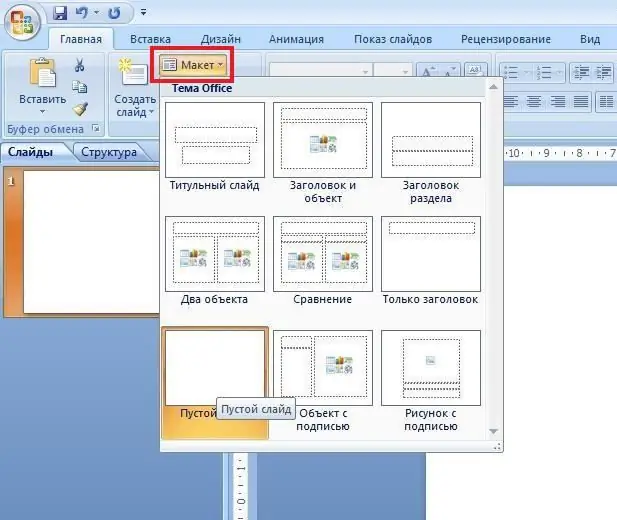Before you start filling the Power Point presentation with objects, you need to prepare the slides: create a number of them, choose a layout for a more convenient arrangement of objects and customize the design. The following guidelines will be given for Power Point 2007 with notes for the 2003 version.

Necessary
- Computer
- Microsoft Office Power Point
- Ability to work according to instructions
Instructions
Step 1
Ways to create new slides.
In order to freely dispose of the available material and change the structure of the presentation, you need to prepare several blank slides.
1. In the slide panel on the left, right-click; in the context menu, select the New Slide command. The same can be done in the sorter mode.
2. Tab "Home" - "Create slide".
Note: In Power Point 2003, the menu "Insert" - "New Slide" and the button "New Slide" on the toolbar.
It is more convenient to change the order of slides in the sorter view. The button for switching to this mode is located in the "View" menu, as well as in the lower part of the window: in the 2007 version on the right, next to the scale, in the 2003 version - on the left, under the slides panel.

Step 2
Slide layout.
To speed up your work, you can use layout layouts for a title slide, a slide with a title and subheading, a title and a list, etc.
1. On the Home tab of the ribbon, locate the Layout button. Call up the list.
2. To apply the selected layout, left-click on it.
Note: In Power Point 2003, Slide Layout is in the task pane (to the right of the current slide). To select a layout layout, left-click on it. To select options for applying the markup, right-click on the sample.
If you want to freely dispose of the slide space without using a predetermined arrangement of objects, then use the "Blank Slide" markup. This will allow you to randomly insert any object on the slide.

Step 3
Slide design.
For the presentation to acquire a face, you need to apply a certain color scheme to it.
1. On the ribbon, select the Design tab.
2. Move the mouse pointer over the design samples and view them on the current slide.
3. To apply the template you like to all slides, left-click on it. If you need use cases, right-click on the sample in the ribbon and select the option you want from the context menu (for example, "Apply to Selected Slides").
Note: In Power Point 2003, "Slide Design" is in the task pane (to the right of the current slide). The design templates are selected separately, containing certain fonts and color schemes by default. Design options are also selected by right-clicking on the sample.
You can create a presentation background without using templates. Just right-click on the current slide and select Format Background (in Power Point - "Background"). The background settings window will open, where you will change the required parameters.
Remember to contrast the background of your presentation with the color of the text: dark background and light text, light background and dark text. This facilitates the perception of information. The minimum font size is 18 for text and 22 for headings. No more than 2 different types of fonts can be used in the presentation, preferably sans serif (for example, Arial).






